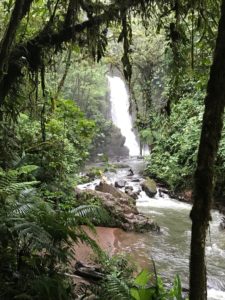How to drive to Poas Volcano National Park
Enchanting Poás
One of the most popular day trips for visitors looking to discover Costa Rican culture and unforgettable scenery is a trip to Poás Volcano National Park and surrounding pueblos, Fraijanes and Vara Blanca. Located only 33 km from Juan Santamaria International Airport in Alajuela, the roughly one-hour drive will take you through the fresh and verdant countryside of the country’s Central Valley highlands and into tiny pueblos with quaint shops and homes puffing smoke from their chimneys to keep the cool of the mists and frequent rains at bay. Pass countless coffee, flower, and strawberry plantations, as well as small herds of dairy cattle, and tall tropical pine forests on your way into the country’s highest elevations.
Driving to the volcano
Unlike many Costa Rican thoroughfares, road signs to Poás National Park are abundant; nonetheless, GPS, Waze, or Google Maps will take the headache out of navigation and leave you free to enjoy the scenery. From the airport take Route 1, Carretera Interamericana (Pan-American Highway) north for approximately 250 meters before merging right (east) onto the Radial Francisco J. Orlich; continue straight for about 3 km, the road will turn into Street (Calle) 2; at the Bar Chicharronera take Route 712 up into the mountains for 17 km; turn right onto Route 146 and you’ll pass through the town of Fraijanes before taking another right onto Route 120 (at Hotel El Churrasco) that leads to Poás National Park.
Volcanic activity
Since April 2017, the Poás Volcano has emitted a series of eruptions resulting in temporary closures of the park and evacuation of some nearby residents. Since then, Costa Rica’s National System of Areas of Conservation (SINAC) has worked diligently to improve safety measures and reopen. Visitor access is limited and ticket reservations much be made online at: https://serviciosenlinea.sinac.go.cr/ prior to visiting.
The National Park
The volcano has one of the largest craters in the world as well as two crater lakes near its summit. Laguna Caliente (Hot Lake) crater is also considered one of the world’s most acidic lakes, with a layer of liquid sulfur at its deepest point and is sometimes responsible for acidifying the area’s rain and fog affecting the surrounding vegetation. Lago Botos, a lake named for an indigenous tribe that populated this area, fills an inactive crater, which last erupted in 7500 B.C. It is cold and clear, and is surrounded by a dwarf cloud forest within the National Park boundaries. Well maintained hiking trails, ranging from easy to moderate, lead through the mountain’s otherworldly vegetation up to both craters where visitors can gaze into the steamy depths and take photographs.
What to do in the area
There are wonderful things to do and see in Fraijanes and Vara Blanca, including trout fishing at one of the many local eateries where your catch will be cooked over an open fire and served with traditional delicacies grown on the volcano’s fertile slopes. One such gem is the Colinas de Poás restaurant and recreation center where guests can also rent kayaks and glide across the centers naturally formed lake, or take a zip-line canopy tour across the forested grounds.
Other musts include the La Paz Waterfall Gardens in nearby Vara Blanca, where you can hike from waterfall to waterfall on expertly landscaped trails and visit the park’s butterfly and hummingbird gardens, serpentarium, and other wildlife displays featuring over 100 species of animals, including jaguars, pumas, ocelots, and margays.
From bean to cup
Visitors also rave about tours to the birthplace of one of the world’s most coveted beverages – the coffee plantation. Doka Estate’s coffee is grown on the volcano’s productive flanks and is one of the country’s largest producers. Visitors will learn about the coffee process, ranging from seed germination to plant development and finally harvesting and roasting. Tours can be arranged to include lunch and a hike to the volcano so ask ahead.
Family fun
Bosques de Frijanes (Friars’ Forest) a local favorite, is a perfect spot for a hike and picnic with the whole family. The park asks a small entrance fee that grants visitors access to the winding trails, lake, picnic tables, petting farm, and amenities. Horseback riding, cabins, and camping areas are available for an additional cost.
Authentic Costa Rica
The quaint Fraijanes town offers a number of locally-owned shops where one can find hand-carved souvenirs, t-shirts and other keepsakes, as well as locally-produced cheeses, honey, and sweets. Steakhouses and traditional-fare restaurants also abound so enjoy a full day of fun and food. Arrive early as afternoon showers are common year round.


Leave a Reply